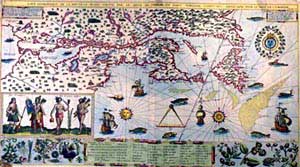8a. New France

French explorer Champlain had visited and mapped the New England coast a number of times before the Pilgrims arrived in 1620. This map of New France was drawn in 1612 and includes all of what is now New England.
About the same time John Smith and the Jamestown settlers were setting up camp in Virginia, France was building permanent settlements of their own. Samuel de Champlain led a group of French colonists through the mouth of the St. Lawrence River to found Quebec in 1608. The fur trade led fortune seekers deeper and deeper into North America. French Jesuit missionaries boldly penetrated the wilderness in the hopes of converting Native Americans to Catholicism. By 1700, France had laid claim to an expanse of territory that ranged from Newfoundland in the Northeast, down across the Great Lakes through the Ohio Valley, southward along the Mississippi River to the Gulf of Mexico, and as far west as the Rocky Mountains.
There were profound differences between New England and New France. The English colonies, though much smaller in area, dwarfed the French colonization in population. Louis XIV was a devout Catholic and tolerated no other faiths within the French Empire. French Huguenots, the dominant religious minority, therefore found no haven in New France. Land was less of an issue in France than England, so French peasants had less economic incentive to leave. The French Crown was far more interested in its holdings in the Far East and the sugar islands of the Caribbean, so the French monarchs did little to sponsor emigration to North America. Eventually, the sparse French population would be no match for the more numerous British colonists as the wars raged on.
Unlike the English colonies where self-rule had been pursued immediately, the people of New France had no such privileges. There were no elected assemblies. Decisions were made by local magistrates on behalf of the French king. Trial by jury did not exist, nor did a free press. The French citizenry depended directly on the Crown for guidance. The English colonists depended on themselves. In the end, despite huge claims to North American lands, the French would be overwhelmed by more numerous, self-directed subjects of Britain.
French cultural contributions are still felt in the modern United States. Cajun and Creole food draw from French culinary traditions. We need look no further than the map: Des Moines, Detroit, St. Louis, Grand Teton, and New Orleans, to see but some of France's enduring influence.






